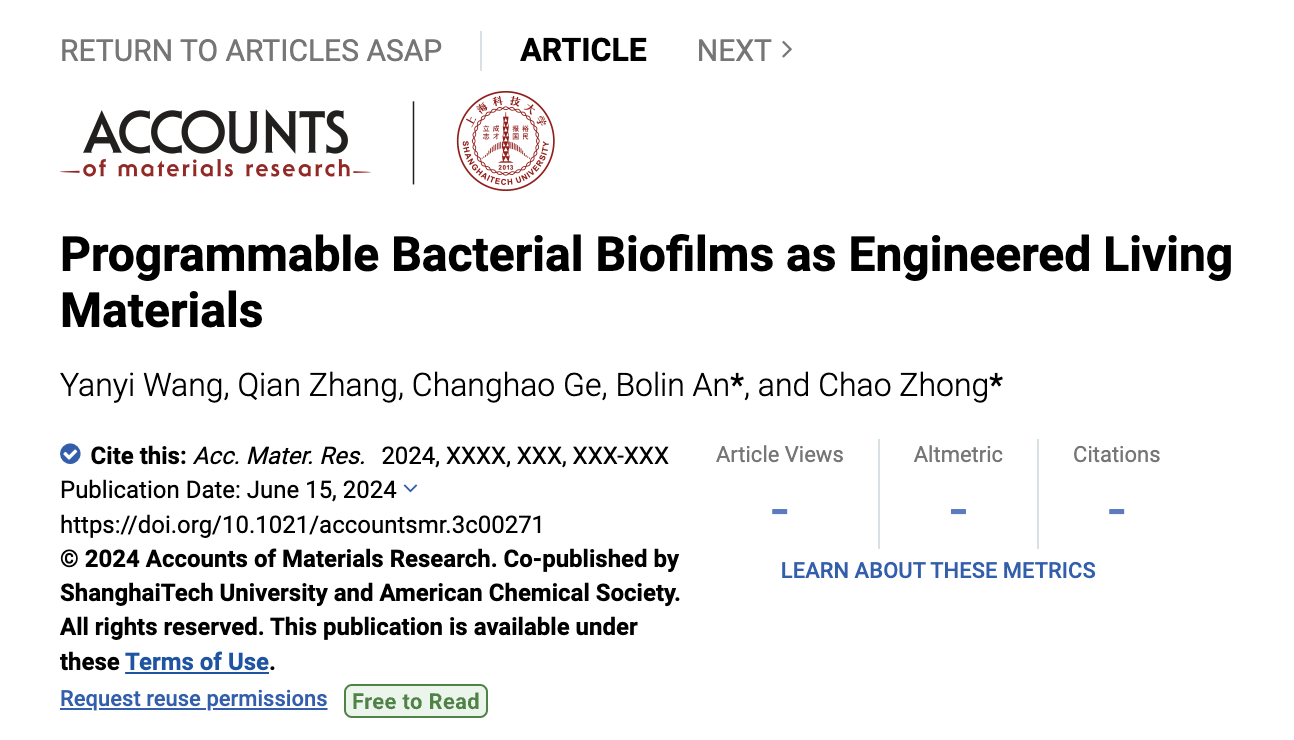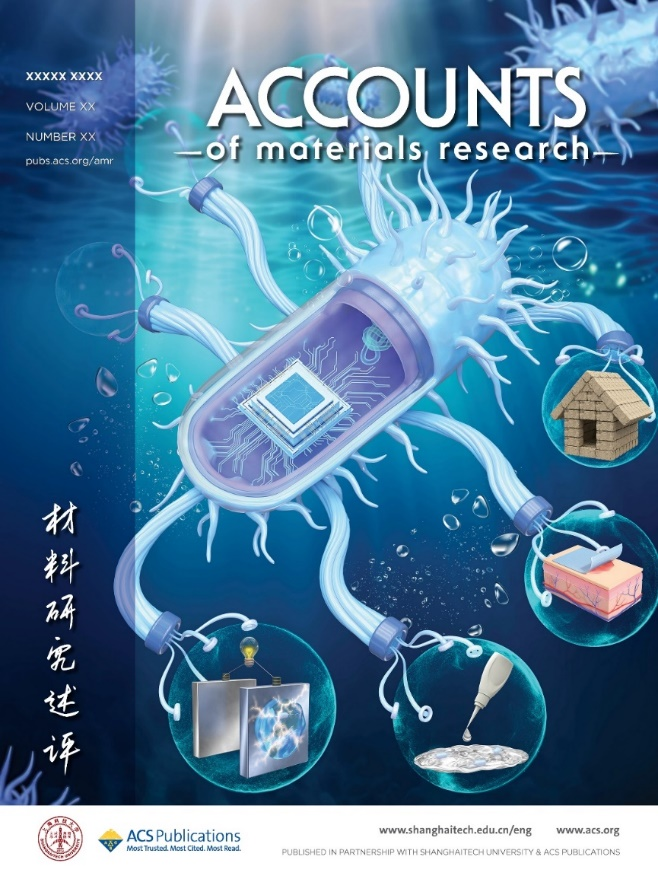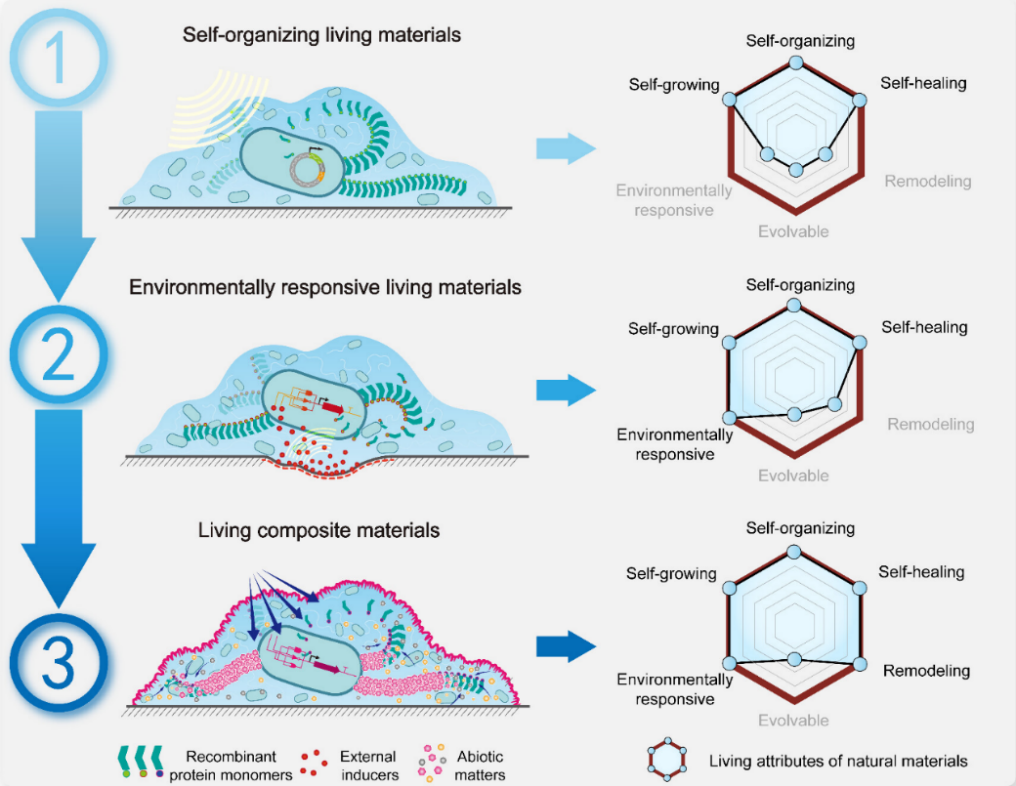
Recently, the team led by Researcher Zhong Chao from the Institute of Synthetic Biology of the SIAT, published an invited review article titled "Programmable Bacterial Biofilms as Engineered Living Materials" online in the internationally renowned academic journal Accounts of Materials Research. The article discusses significant progress in the emerging field of engineered living materials based on bacterial biofilms and presents new perspectives and thoughts on the future development and challenges of such materials. Additionally, this study was selected as a cover article for the interior pages of the journal Accounts of Materials Research.

Screenshot of the article online
Link: https://pubs.acs.org/doi/full/10.1021/accountsmr.3c00271
To adapt to turbulent living environments, bacteria and other microorganisms often secrete extracellular matrices based on protein fibers (such as Escherichia coli curli fibers) or polysaccharides (such as bacterial cellulose from Acetobacter) to encapsulate themselves, forming a non-planktonic aggregate of bacteria and extracellular matrix known as a biofilm. Bacterial biofilms exhibit extremely high stability, resistance to adversity, and programmable functionality of their components. At the intersection of synthetic biology and materials science, bacterial biofilms are being used as an economical and convenient design platform to create engineered living materials (ELMs) that can replicate the "life" dynamic properties of natural materials. The currently developed active biofilm materials have shown broad application prospects in the fields of construction, healthcare, energy, and environment (Figure 1).

Figure 1 The illustration was selected for the cover of the "Accounts of Materials Research" (Illustrator: Yin Zhongchuan)
In this article, the authors distilled six major dynamic characteristics of natural biological materials: self-growth, self-organizing, self-repair, environmental adaptation, self-reconfiguration, and evolvability. Using these characteristics as criteria for evaluating the degree of biomimetic nature, the currently developed biofilm living materials can be categorized into three main types: 1) Self-organizing living materials, 2) Environment-responsive living materials, and 3) Living composites (Figure 2). Self-organizing living materials primarily utilize bacterial secretions of self-organizing proteins or polysaccharide extracellular matrices, customizing the functions of biofilms through genetic modification of their monomeric components. For example, recombinant biofilms with virus adhesion peptide C5 and curli protein have been designed to possess the biological function of adsorbing and removing influenza virus in aqueous solutions. Environment-responsive living materials refer to those that incorporate artificially designed sensing circuits into microbial genetic material, thereby endowing biofilm materials with the capability to dynamically respond to changes in the external environment. For instance, probiotic living materials encoding blood or thiosulfate sensing circuits can be used for precise localization of intestinal inflammation lesions and actively perform hemostatic and anti-inflammatory functions. Living composites involve combining genetically engineered biofilms with inactive or synthetic substances, integrating the living characteristics of biofilms with the excellent properties of synthetic materials. Typical applications include hybrid biofilms with inorganic semiconductor particles for photosynthetic carbon fixation or hydrogen production, as well as engineering biofilms for mass production of eco-friendly bricks and other sustainable applications.

Figure 2 Three Types of Engineered Living Materials Based on Bacterial Biofilms: ① Self-organizing Living Materials; ② Environment-Responsive Living Materials; ③ Living Composite Materials
The evolution from simple to complex structures and functions follows a gradual progression among self-organizing living materials, environment-responsive living materials, and living composites: Self-organizing living materials form the foundation, retaining the living characteristics of biofilms such as self-growth, self-organizing, and self-repair; further integration of genetic sensing circuits leads to the emergence of responsive living materials capable of perceiving and responding to specific external environmental signals; living composites build upon the previous two types by incorporating inactive functional components, enhancing the reshaping capabilities of living materials and broadening their application scope. The article details these three categories of biofilm-based living materials, highlighting their respective design strategies and significant applications. Additionally, addressing the application challenges of biofilm-based living materials, the article offers new insights into how to further enhance material performance and facilitate the real-world application of living materials.
Researcher Zhong Chao and Associate Researcher An Bolin from the Institute of Synthetic Biology of the SIAT, are the co-corresponding authors of this paper. Associate Researcher Wang Yanyi and Postdoctoral Researcher Zhang Qian are the co-first authors, with significant contributions also made by Research Assistant Ge Changhao, Liu Yuzhu, Professor Zheng Yijun from ShanghaiTech University, Postdoctoral Researcher Jiang Xiaoyu, Master's Student Chen Shaojie, and Postdoctoral Researcher Tang Zijie from the Wyss Institute at Harvard University. This study was supported by programs including the National Key R&D Program, the National Science Fund for Distinguished Young Scholars, the National Natural Science Foundation, and the Shenzhen Key Laboratory for Synthetic Biology Materials.